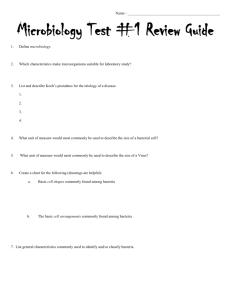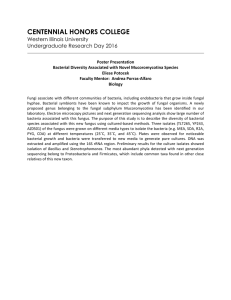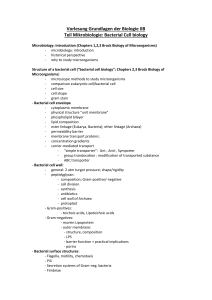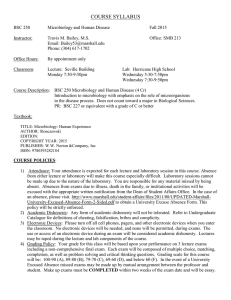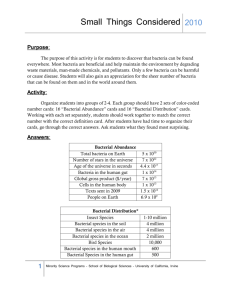Syllabus Checklist
advertisement
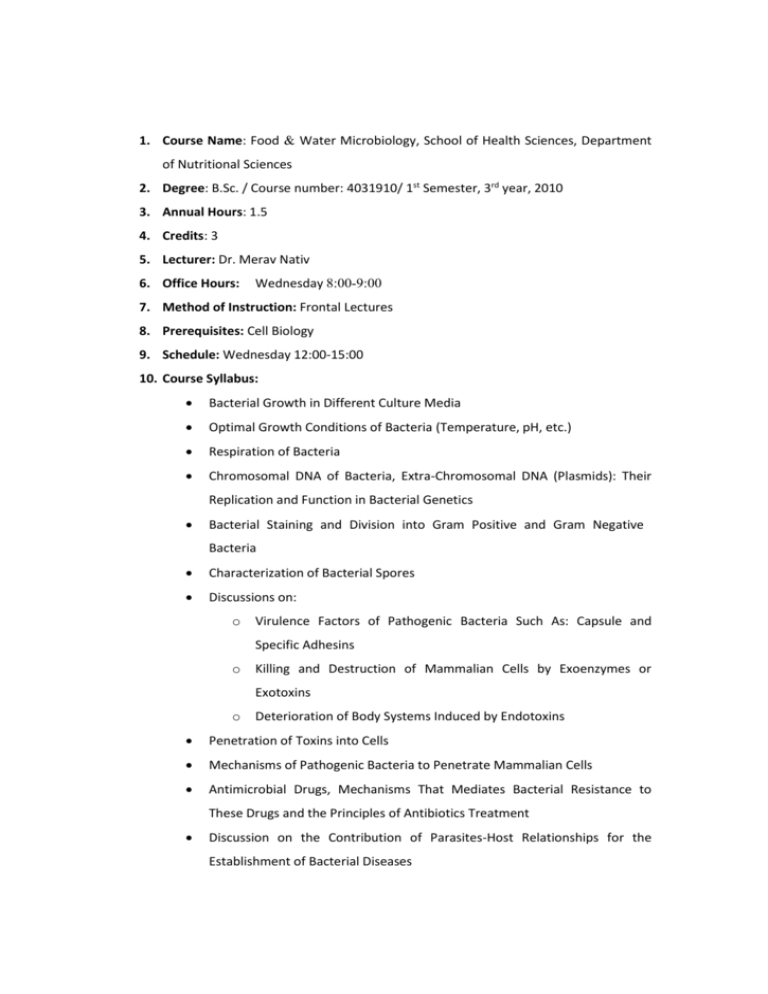
1. Course Name: Food & Water Microbiology, School of Health Sciences, Department of Nutritional Sciences 2. Degree: B.Sc. / Course number: 4031910/ 1st Semester, 3rd year, 2010 3. Annual Hours: 1.5 4. Credits: 3 5. Lecturer: Dr. Merav Nativ 6. Office Hours: Wednesday 8:00-9:00 7. Method of Instruction: Frontal Lectures 8. Prerequisites: Cell Biology 9. Schedule: Wednesday 12:00-15:00 10. Course Syllabus: Bacterial Growth in Different Culture Media Optimal Growth Conditions of Bacteria (Temperature, pH, etc.) Respiration of Bacteria Chromosomal DNA of Bacteria, Extra-Chromosomal DNA (Plasmids): Their Replication and Function in Bacterial Genetics Bacterial Staining and Division into Gram Positive and Gram Negative Bacteria Characterization of Bacterial Spores Discussions on: o Virulence Factors of Pathogenic Bacteria Such As: Capsule and Specific Adhesins o Killing and Destruction of Mammalian Cells by Exoenzymes or Exotoxins o Deterioration of Body Systems Induced by Endotoxins Penetration of Toxins into Cells Mechanisms of Pathogenic Bacteria to Penetrate Mammalian Cells Antimicrobial Drugs, Mechanisms That Mediates Bacterial Resistance to These Drugs and the Principles of Antibiotics Treatment Discussion on the Contribution of Parasites-Host Relationships for the Establishment of Bacterial Diseases Familiar Ourselves with Bacteria Such As Mesophile, Thermophile, Psychrophile, Acidophiles, Neutrophiles, Alkaliphiles, Etc. Discussed the Following Terms: Sterilization, Disinfection & Antiseptic and the Important Difference between Them in The Food Industry. Extensively Discuss Cellulose Decomposers in the Colon, Fungi And Mycotoxins, Viruses and Various Parasites and the Different Opinions Regarding Probiotics. Depict the Process of Cleaning the Water in Israel's National Water Carrier, the Water Tests for Microbial Quality, Sampling and Testing, Cleaning of Water in Household Appliances, Water Springs and Streams. Understand the Ways of Saving the Animal Origin Foods, Canned or Processed Foods, Honey and Swollen Canned Food Tins. Briefly Refer to Microorganisms in the Food Industry: Cheese, Sausages, Pickles, Beer and Wine and Conclude with Several Groups of Bacteria That Cause Common Food Poisoning. 11. Bibliography: Madigan, Martinko and Parker, Brock Biology of Microorganisms, 8th Edition, Prentice Hall, Englewood Cliffs, NJ, U.S.A., 2000. Doyle, Beuchat and Montville, Food Microbiology, Washington DC, American Society of Microbiology, 1997. D.C Waryl, Standard Methods for Water and Wastewater Examinations (AOAC), 20th Edition, U. S Govermment Publication, 1998. D.C Waryl, Stanard Methods for Dairy Products (APHA), U. S Govermment Publication, 1996. Salyera and Whitt. Bacterial Pathogenesis A Molecular Approach. Editors. A.S.M Press. Washington D.C. second edition, 2002. Robinson, Batt and Patel. Encyclopedia of Food Microbiology, 1999. The World of Bacteria, The Open University of Israel Articles: o Markowitz J.E. and Bengmark S., Probiotics in health and disease in the pediatric patient. Pediatr aclin North Am, 2002; 49: 127-141. o Walker W.A., Role of nutrients and bacterial colonization in the development of intestinal host defense. J Pediatr Gastroenterol Nutr, 2000; 30 (Suppl 2): S2-7 30. 12. Course Requirements: Weekly Tutorial Reports Final Exam 13. Date of the Examination: At the end of the semester at a date determined by the Examinations Division.
